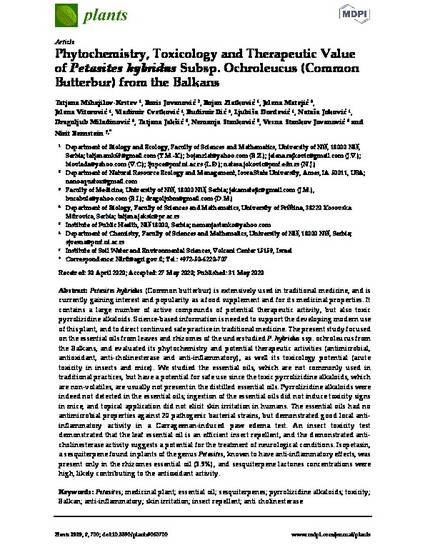
Petasites hybridus (Common butterbur) is extensively used in traditional medicine, and is currently gaining interest and popularity as a food supplement and for its medicinal properties. It contains a large number of active compounds of potential therapeutic activity, but also toxic pyrrolizidine alkaloids. Science-based information is needed to support the developing modern use of this plant, and to direct continued safe practice in traditional medicine. The present study focused on the essential oils from leaves and rhizomes of the understudied P. hybridus ssp. ochroleucus from the Balkans, and evaluated its phytochemistry and potential therapeutic activities (antimicrobial, antioxidant, anti-cholinesterase and anti-inflammatory), as well its toxicology potential (acute toxicity in insects and mice). We studied the essential oils, which are not commonly used in traditional practices, but have a potential for safe use since the toxic pyrrolizidine alkaloids, which are non-volatiles, are usually not present in the distilled essential oils. Pyrrolizidine alkaloids were indeed not detected in the essential oils; ingestion of the essential oils did not induce toxicity signs in mice, and topical application did not elicit skin irritation in humans. The essential oils had no antimicrobial properties against 20 pathogenic bacterial strains, but demonstrated good local anti-inflammatory activity in a Carrageenan-induced paw edema test. An insect toxicity test demonstrated that the leaf essential oil is an efficient insect repellent, and the demonstrated anti-cholinesterase activity suggests a potential for the treatment of neurological conditions. Isopetasin, a sesquiterpene found in plants of the genus Petasites, known to have anti-inflammatory effects, was present only in the rhizomes essential oil (3.9%), and sesquiterpene lactones concentrations were high, likely contributing to the antioxidant activity.
Available at: http://works.bepress.com/boris-jovanovic/18/

This article is published as Mihajilov-Krstev, Tatjana, Boris Jovanović, Bojan Zlatković, Jelena Matejić, Jelena Vitorović, Vladimir Cvetković, Budimir Ilić et al. "Phytochemistry, Toxicology and Therapeutic Value of Petasites hybridus Subsp. Ochroleucus (Common Butterbur) from the Balkans." Plants 9, no. 6 (2020): 700. doi: 10.3390/plants9060700.